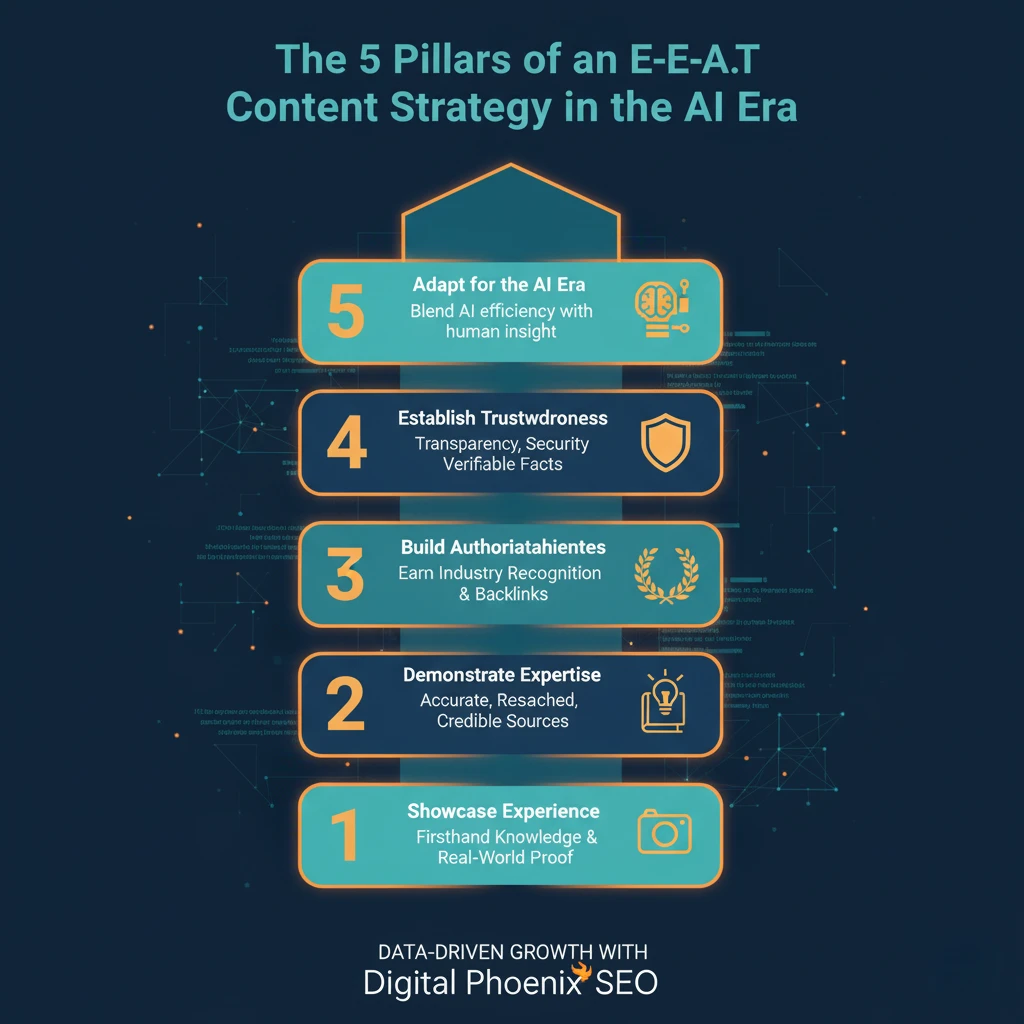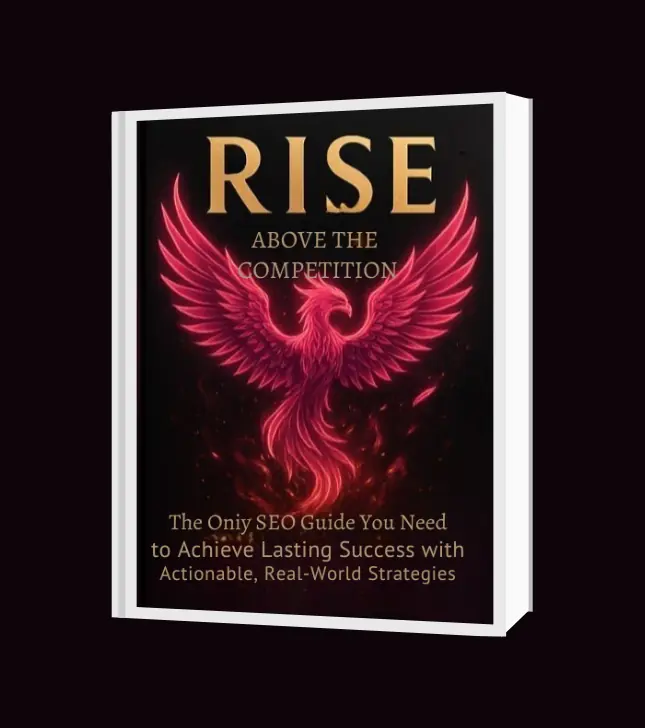In today’s AI-driven search landscape, Google’s focus on E-E-A-T content strategy (Experience, Expertise, Authoritativeness, and Trustworthiness) is more critical than ever. As generative AI reshapes how information is created and consumed, businesses must double down on building credibility, authenticity, and user-first content. Without a clear approach to E-E-A-T, websites risk being buried beneath competitors who prove their authority.
This blog will explore the five pillars of an effective E-E-A-T content strategy, providing actionable steps and real-world examples to help you thrive in the AI era.
Pillar 1: Showcasing Experience
The first element of an E-E-A-T content strategy is demonstrating real-world experience. Google prioritizes content written by those who have firsthand knowledge or have lived through what they are writing about. This helps users trust the information and differentiate it from generic, AI-generated content.
For example, a nutrition coach writing about weight loss should highlight personal client success stories, meal plan examples, or before-and-after case studies. Adding photos, videos, or testimonials strengthens credibility by showing real-world evidence. In contrast, generic articles that lack lived experiences often feel shallow and are less likely to resonate with readers.
Think of it like choosing a fitness trainer. Would you trust a trainer who has transformed dozens of clients’ lives or one who only repeats information from a textbook? Experience proves value, and Google rewards content that clearly shows it.
Pillar 2: Demonstrating Expertise
Expertise is the backbone of an E-E-A-T content strategy. It ensures your audience and search engines see you as a knowledgeable authority in your field. Content should be accurate, well-researched, and supported by credible sources.
For instance, if a cybersecurity firm writes about preventing data breaches, including citations from industry studies, expert interviews, and real-world attack scenarios enhances trust. The goal is to ensure content isn’t just opinion-based but grounded in evidence.
One practical tactic is to leverage author bios that highlight qualifications. A blog post on tax planning, for example, should feature a licensed CPA as the author or reviewer. This not only builds credibility but also reassures readers that the information is reliable.
Pillar 3: Building Authoritativeness
Authoritativeness goes beyond expertise—it’s about how others perceive you in your industry. An E-E-A-T content strategy must include efforts to earn recognition and validation from external sources. Backlinks, mentions in reputable publications, and industry awards all contribute to perceived authority.
For example, a local bakery in Austin might publish a case study on how they optimized their website for local SEO, leading to a 20% increase in online orders. If that story is then picked up by a regional news site, the bakery’s authority in the local market grows. The combination of real results and third-party recognition strengthens their standing.
Comparatively, think of authority like being invited to speak at a conference. The more others seek your insights, the more your reputation grows. Authority is both earned and signaled, and Google pays close attention to it.
Pillar 4: Establishing Trustworthiness
Trust is the foundation of any E-E-A-T content strategy. Users want to know they can rely on your content without being misled. This means ensuring transparency, accuracy, and security across your website.
Practical steps include:
- Displaying clear author names and contact information
- Securing your site with HTTPS
- Avoiding misleading or exaggerated claims
- Including customer reviews and testimonials
For example, an e-commerce store can boost trust by showcasing verified reviews, return policies, and customer support options. A blog on financial advice might increase transparency by disclosing risks and linking to official regulatory sites. These small yet powerful signals tell both users and Google that your site is dependable.
Trust is fragile—like waiting in line at a store, if the process feels shady or confusing, customers leave. Ensuring transparency at every touchpoint fosters loyalty and higher rankings.
Pillar 5: Adapting E-E-A-T for the AI Era
The final pillar of an E-E-A-T content strategy is adapting to the AI era. With search engines increasingly incorporating generative AI, businesses must emphasize human touchpoints and clarity. AI tools can help streamline research and draft outlines, but the human layer of originality, expertise, and storytelling is irreplaceable.
For instance, companies can use AI to analyze trending topics or competitor strategies but should rely on human subject-matter experts to craft narratives. Combining AI efficiency with authentic human insight creates a balanced approach that resonates with both algorithms and readers.
A practical demonstration: if a travel agency uses AI to draft itineraries, human editors should enrich them with personal travel experiences, hidden gems, and cultural insights. This blend ensures the final product embodies E-E-A-T principles while benefiting from AI speed.
Real-World Application: E-E-A-T in Action
Let’s look at a SaaS company that adopted a strong E-E-A-T content strategy. By assigning subject-matter experts to their blog, citing peer-reviewed research, and publishing case studies featuring client successes, the company doubled its organic traffic in six months. Their content was also quoted in industry newsletters, boosting authority and credibility.
Without E-E-A-T, their AI-driven competitors produced generic blogs that failed to engage users. With E-E-A-T, they became the trusted voice in their niche.
Final Thoughts
The AI era has raised the bar for content quality. A well-executed E-E-A-T content strategy is no longer optional—it’s essential for ranking well, building user trust, and driving sustainable growth. By focusing on experience, expertise, authoritativeness, trustworthiness, and adaptation to AI, businesses can future-proof their content strategies.
Think of E-E-A-T as the five pillars of a strong foundation. Without them, your content risks collapsing under the weight of AI-generated competition. With them, your brand can thrive and dominate search results.
Ready to Build a Winning E-E-A-T Content Strategy?
At Digital Phoenix SEO, we help businesses design and implement powerful content strategies built on E-E-A-T principles. Our team blends AI efficiency with human expertise to ensure your content ranks higher, builds trust, and drives measurable growth.
Schedule a free strategy call today and discover how we can help you create an E-E-A-T content strategy that thrives in the AI era.




